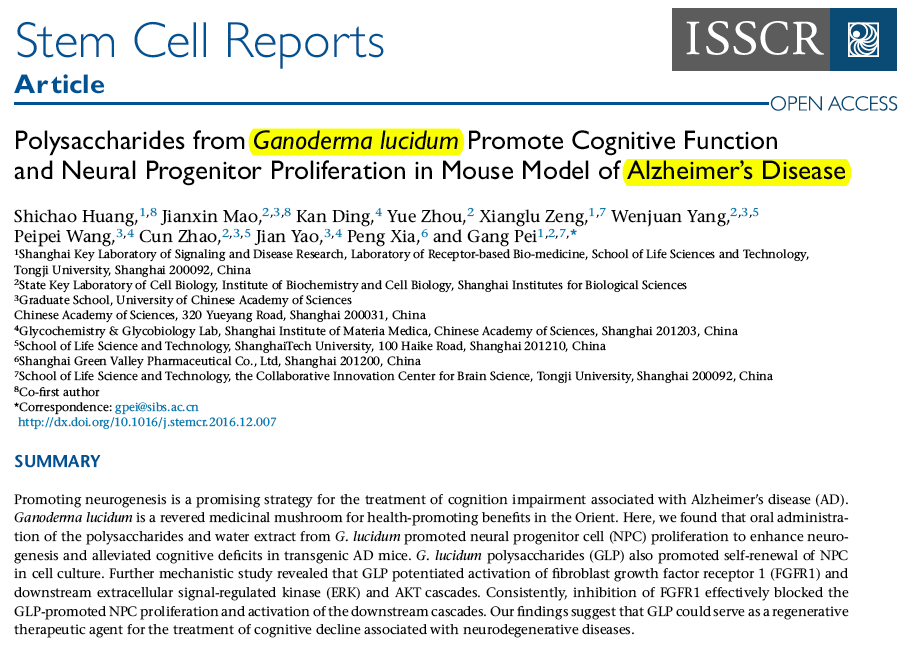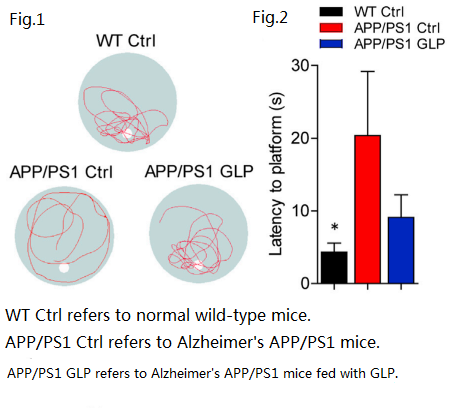январь 10, 2017 /Университет Тунцзи, Шанхайский институт Материи медики, Китайская академия наук, и т. д.. / Отчеты о стволовых клетках
Текст/У Тинъяо

«Забудь, кто ты и кто я», можно сказать, является наиболее типичным симптомом болезни Альцгеймера.. Причина забытья, или неспособность вспомнить недавние события, заключается в том, что нервные клетки, отвечающие за когнитивные функции, с годами постепенно умирают., из-за чего когнитивный уровень взрослого человека продолжает ухудшаться..
Столкнувшись с этой все более распространенной болезнью Альцгеймера, ученые усердно работают над изучением возможных методов лечения. Некоторые люди сосредотачиваются на виновнике гибели нервных клеток., пытаясь уменьшить выработку белка бета-амилоида; другие стремятся способствовать регенерации нервных клеток, надеясь восполнить вакансию повреждения нервных клеток, возможно, это концепция «восстановления, если чего-то не хватает».
В мозге зрелых млекопитающих, действительно есть две области, которые продолжают производить новые нервные клетки, один из которых находится в извилине гиппокампа. Эти самопролиферирующие нервные клетки называются «нейральными клетками-предшественниками».. Новорожденные из них клетки будут добавлены к исходным нейронным цепям, чтобы помочь освоить новые навыки и сформировать новые воспоминания..
Однако, у людей или мышей можно наблюдать, что болезнь Альцгеймера может нарушать пролиферацию нервных клеток-предшественников.. Настоящее время, Все больше и больше данных указывают на то, что стимулирование пролиферации нейрональных клеток-предшественников может уменьшить ухудшение когнитивных функций, вызванное болезнью Альцгеймера, и может стать реальной стратегией лечения болезни Альцгеймера..
В январе 2017, исследование, совместно опубликованное в журнале «Stem Cell Reports» Университета Тунцзи, Шанхайские институты биологических наук, Китайская академия наук, и т. д., доказали, что полисахариды или водные экстракты из Ганодерма яркая(Гриб Рейши, Линчжи) может облегчить когнитивные нарушения, вызванные болезнью Альцгеймера, уменьшить отложение амилоида-β (Аβ) в мозгу, и способствуют регенерации нейрональных клеток-предшественников в извилине гиппокампа.. Последний механизм действия, вероятно, связан с активацией рецептора FGFR1 на нервных клетках-предшественниках вследствие регуляции Ганодерма яркая.
Мыши с болезнью Альцгеймера, которые едятГанодерма яркая иметь лучшую память.
В экспериментах на животных в этом исследовании использовались 5 трансгенным мышам APP/PS1 в возрасте 6 месяцев, т.е., использование технологии переноса генов для переноса мутантных человеческих генов APP и PS1 (которые могут вызвать наследственную болезнь Альцгеймера с ранним началом) в новорожденных мышей для эффективной экспрессии генов. Это заставит мозг мышей начать вырабатывать амилоид-β. (Аβ) с юных лет (после 2 месяцев возраста), и когда они вырастут 5-6 месяцев возраста, у них постепенно будут развиваться трудности с пространственным распознаванием и памятью..
Другими словами, мыши, использованные в эксперименте, уже имели начальные симптомы болезни Альцгеймера. Исследователи кормили таких мышей с болезнью Альцгеймера GLP. (чистые полисахариды, выделенные изГанодерма яркая споровый порошок с молекулярной массой 15 кД) в суточной дозе 30 мг/кг (то есть, 30 мг на килограмм массы тела в день) для 90 дни подряд.
Затем, исследователи провели еще один 12 дней тестирования когнитивных способностей мышей в водном лабиринте Морриса (МВМ) и сравнили их с мышами с болезнью Альцгеймера, не получавшими никакого медицинского лечения, и с мышами нормальными..
Мыши испытывают естественное отвращение к воде. Когда их опускают в воду, они попытаются найти сухое место для отдыха. «Испытание водного лабиринта Морриса» использует их природу для установки платформы для отдыха в фиксированном месте в большом круглом бассейне.. Так как платформа скрыта под водой, мышам придется найти его, только выучив и запомнив. Как результат, исследователи смогли судить, стали ли мыши тупее или умнее к тому времени, когда мыши нашли платформу, расстояние, которое они проплыли, и путь, который они прошли.
Было обнаружено, что не было существенной разницы в скорости плавания мышей в каждой группе.. Но по сравнению с обычными мышами, Мышам с болезнью Альцгеймера, не получавшим никакого лечения, приходилось тратить больше времени и проплывать большие расстояния, чтобы найти платформу по беспорядочной траектории, как будто на удачу., что указывает на то, что их пространственная память была значительно нарушена..
В отличие, Мышей с болезнью Альцгеймера кормили Гриб Рейши полисахариды или Ганодерма яркая водная вытяжка быстрее нашла платформу, и прежде чем найти платформу, они в основном бродили по местности (квадрант) где находилась платформа, как будто знали примерное расположение платформы, что указывает на то, что повреждение их мозга менее серьезное. 【Фигура 1, Рисунок 2】
Кроме того, В другом эксперименте исследователи также заметили, что у плодовых мух, которые производят большое количество амилоида-β, (Аβ) в их мозгах (также с помощью методов переноса генов для создания экспериментальных моделей), Ганодерма яркая Водный экстракт может не только улучшить пространственное распознавание и способность памяти плодовых мух, но и продлить их продолжительность жизни..
Исследователи также использовалиГанодерма яркая водный экстракт (300мг/кг в день) в вышеупомянутых экспериментах на животных и обнаружил, что он также может облегчить нарушения пространственной когнитивной функции, вызванные болезнью Альцгеймера, как и вышеупомянутый препарат.Ганодерма яркая полисахариды (GLP).

Используйте «Тест Морриса в водном лабиринте», чтобы оценить способность мышей к пространственной памяти.
[Фигура 1] Пути плавания мышей в каждой группе. Синий - это бассейн, белый — позиция платформы, а красный - это плавательная дорожка.
[Фигура 2] Среднее время, необходимое каждой группе мышей, чтобы найти платформу для отдыха на 7-й день теста в водном лабиринте Морриса
(Отчеты об источниках/стволовых клетках. 2017 Ян 10;8(1):84-94.)
Линчжи способствует пролиферации нервных клеток-предшественников в извилине гиппокампа.
После 12-дневного испытания в водном лабиринте, Исследователи проанализировали мозг мышей и обнаружили, чтоГанодерма яркая полисахариды иГанодерма яркая водные экстракты способствуют регенерации нервных клеток в извилине гиппокампа и уменьшают отложение β-амилоида..
Далее было подтверждено, что новорожденные нервные клетки в извилине гиппокампа в основном представляют собой нейрональные клетки-предшественники. ИГанодерма яркая эффективен для мышей с болезнью Альцгеймера. Кормление нормальных молодых взрослых мышейГанодерма яркая полисахариды(GLP) в суточной дозе 30 мг/кг для 14 дней может также способствовать пролиферации нервных клеток-предшественников в извилине гиппокампа..
Эксперименты in vitro также подтвердили, что для нервных клеток-предшественников, выделенных из гиппокампальной извилины нормальных взрослых мышей или мышей с болезнью Альцгеймера, или нервных клеток-предшественников, полученных из стволовых клеток человека,, Ганодерма яркая полисахариды могут эффективно способствовать пролиферации этих клеток-предшественников., и вновь созданные клетки сохраняют исходные характеристики нервных клеток-предшественников., то есть, они могут осуществлять пролиферацию и самообновление.
Дальнейший анализ показал, чтоГанодерма яркая полисахариды (GLP) могут способствовать нейрогенезу главным образом потому, что они могут усиливать рецептор под названием «FGFR1». (не рецептор EGFR) на нервных клетках-предшественниках, делая его более восприимчивым к стимуляции «фактора роста нервов bFGF»., который отправляет больше информации о «пролиферации клеток» нервным клеткам-предшественникам, и тогда рождаются новые нервные клетки.
Поскольку новорожденные нервные клетки могут в дальнейшем присоединяться к существующим нервным цепям для функционирования после того, как они мигрируют в область мозга, которая в этом нуждается., это должно облегчить ряд когнитивных нарушений, вызванных гибелью нервных клеток при болезни Альцгеймера..
Многогранная рольГанодерма яркая замедляет темп забывания.
Приведенные выше результаты исследований позволяют нам увидеть защитный эффектГанодерма яркая на нервные клетки. Помимо противовоспалительного действия, антиоксидант, антиапоптотический, отложение анти-β-амилоида и другие эффекты, известные в прошлом, Ганодермасветлый также может способствовать нейрогенезу. Для мышей с болезнью Альцгеймера, имеющих те же генетические дефекты и те же симптомы., вот почему тяжесть симптомов заболевания весьма различна у тех, кто естГанодерма яркая и те, кто не естГанодерма яркая.
Ганодерма яркая возможно, не удастся полностью восстановить функцию памяти у пациентов с болезнью Альцгеймера, но его различные механизмы действия могут замедлить ухудшение болезни Альцгеймера.. Пока пациент помнит себя и других на всю оставшуюся жизнь., Болезнь Альцгеймера может быть не такой страшной.
[Источник] Хуан С., и др.. Полисахариды из Ganoderma lucidum способствуют когнитивной функции и пролиферации нервных предшественников на мышиной модели болезни Альцгеймера. Отчеты о стволовых клетках. 2017 Ян 10;8(1):84-94. дои: 10.1016/j.stemcr.2016.12.007.
КОНЕЦ
Об авторе/ г-жа. У Тинъяо
У Тинъяо сообщает информацию из первых рук о Ганодерма с тех пор. 1999. Она является авторомЛечение с помощью Ганодерма (опубликовано в Народном медицинском издательстве в апреле 2017).
★ Статья публикуется с исключительного разрешения автора..
★ Воспроизведение вышеуказанных работ не допускается., извлечены или использованы иным образом без разрешения автора.
★ За нарушение вышеуказанного заявления, автор будет нести соответствующую юридическую ответственность.
★ Оригинальный текст этой статьи был написан на китайском языке У Тинъяо и переведен на английский Альфредом Лю.. Если есть расхождения в переводе (Английский) и оригинал (китайский), оригинальный китайский будет иметь преимущественную силу. Если у читателей возникнут вопросы, пожалуйста, свяжитесь с первоначальным автором, РС. У Тинъяо.



